
Rowing - Specific Scripts / Organizing of Training
How to Create a Good Training-Schedule / Prognosis-Time-Table / Analysis of the Races at the Olympic Games 2000 / The Traffic-Light-Start
The tactic of steady race - course in advance.
Analysis of races at the Olympic Rowing Regatta in Sydney
There have been only six start-finish-victories with the rowing-typical offensive-tactic at the Olympic Rowing Regatta on the Penrith Lakes in 14 Olympic boat-classes. This offensive race tactic, in which one team tries to get a comfortable advance within the first quarter of the race and tries to control the rest of the field with the most possible advance, has been dominant ever since (1999 nine victories of this kind ). Does the tactic of the most possible steady race-pace (more economic, but for the athlete not without problems) gain acceptance more and more? Noticeable in Sydney in the competitions of the men are especially the Italians in the quad and the French in the pair and lightweight coxless four, who made, with a relative even pace, linked with steady catching up, life hard for the ‘fast starters’.Leading team in this comparison, are the Italians in the quad of the men, with only 1,7sec (!) greatest 500m-difference (The difference between the fastest and slowest 500m distance-parts). In the competition of the women, the three winning boats are at the top, with 2,3 – 3,0 sec as widest range.A view on the flat curve of the race-course of these successful teams shows, that this was no coincidence, but method. Even in a couple of start-finish-victories a tendency to achieve this steady pace with an economic use of required power over the whole 2000m race-distance. Interesting especially here the British coxless four and eight of the men.Both concepts have advantages and disadvantages. If the athletes are in a superiority condition, the offensive tactic enables the leading team to keep the rest of the field under control (Example: the German women double). This tactic can result in problems, if one of the pursuer (hunter) is in the same condition and technique (and corresponding nerve-strength), and this team is able, while using power/endurance economically during the race (without power-peaks and without early use of the reserves), to increase the speed on the last 500m part, in case of emergency, significantly (Example: the Italian quad of the men). On the other hand the example of the Norwegian double of the men, during the final against the Slovenians, is showing the limit of this tactic. Here the diagrams of the races in the women competition, in which a German team could achieve medals: F 1x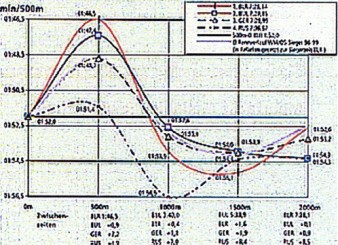 On nearly flat water a quick-start from E. Karsten (BLR). The diagram shows clear, that BLR over pulled on the first 500m, and lost the lead on the second 500m. The boat-speed on the first 500m has been more than 2sec faster than the split of the WM-OS-winner in the last years (see gray shaded curve). Very fast at the start as well Neykova (BUL). K. Rutschow-Stomporowski (GER) stacked nearly exactly to the classic race-course of the winners-split, but still faster than the tactic of most possible even race-profile (widest range of 500m-difference for GER 5,3sec, and BLR 7,9sec , caused by drop of the boat-speed on the second 500m). Very surprising her the ability of E. Karsten, to mobilize reserves at the end-phase, to increase the speed so significantly and win ahead the Bulgarian woman with such a close distance on the finish-line. Was this ability supported / enabled by the low stroke-rate (~31) during the middle of the race? The Bulgarian woman, -after a very quick-start with high speed and a hard fight in the middle-part, could not respond that amazing increase of speed of BLR and GER at the finish. She could save the silver-medal with 84/100sec ahead GER. F 2x
On nearly flat water a quick-start from E. Karsten (BLR). The diagram shows clear, that BLR over pulled on the first 500m, and lost the lead on the second 500m. The boat-speed on the first 500m has been more than 2sec faster than the split of the WM-OS-winner in the last years (see gray shaded curve). Very fast at the start as well Neykova (BUL). K. Rutschow-Stomporowski (GER) stacked nearly exactly to the classic race-course of the winners-split, but still faster than the tactic of most possible even race-profile (widest range of 500m-difference for GER 5,3sec, and BLR 7,9sec , caused by drop of the boat-speed on the second 500m). Very surprising her the ability of E. Karsten, to mobilize reserves at the end-phase, to increase the speed so significantly and win ahead the Bulgarian woman with such a close distance on the finish-line. Was this ability supported / enabled by the low stroke-rate (~31) during the middle of the race? The Bulgarian woman, -after a very quick-start with high speed and a hard fight in the middle-part, could not respond that amazing increase of speed of BLR and GER at the finish. She could save the silver-medal with 84/100sec ahead GER. F 2x 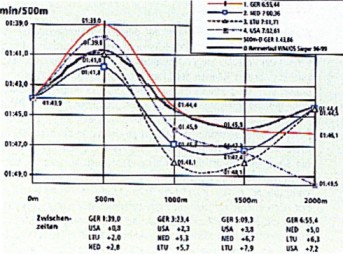 Clear offensive tactic in the German boat, with nearly equal race-tactic as at the WM-final 1999. Boron / Thieme have been the most superiority winner of this regatta, with 5sec advance. They proved the advantages of the offensive tactic, if in superiority conditional shape is granted. Noticeable is, that they rowed the last 3 quarter of the race staying on this high level with nearly even boat-speed. With clear distance followed by the USA, who lost the second place, on the last 500m, against NED and LTU, and came in fourth place at the end. FPL 2x
Clear offensive tactic in the German boat, with nearly equal race-tactic as at the WM-final 1999. Boron / Thieme have been the most superiority winner of this regatta, with 5sec advance. They proved the advantages of the offensive tactic, if in superiority conditional shape is granted. Noticeable is, that they rowed the last 3 quarter of the race staying on this high level with nearly even boat-speed. With clear distance followed by the USA, who lost the second place, on the last 500m, against NED and LTU, and came in fourth place at the end. FPL 2x 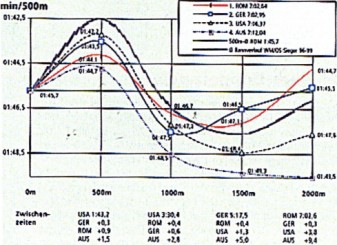 Exiting neck to neck-fight between ROM, GER and USA for the medal-positions, steady change of the positions. The US-girls couldn`t follow on the second 1000m. Drama up to the finish between ROM and GER. Little weakness in the German boat on the second 500m-part. Amazing again the flat race-curve of the Rumanian women (3,0sec range / 500m) with significant increase of the speed in the end-phase. ROM won with 31/100sec ahead of GER. F 4x
Exiting neck to neck-fight between ROM, GER and USA for the medal-positions, steady change of the positions. The US-girls couldn`t follow on the second 1000m. Drama up to the finish between ROM and GER. Little weakness in the German boat on the second 500m-part. Amazing again the flat race-curve of the Rumanian women (3,0sec range / 500m) with significant increase of the speed in the end-phase. ROM won with 31/100sec ahead of GER. F 4x 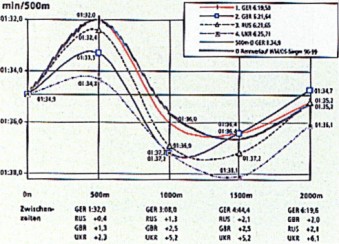 Perfect race-schedule of the German quad, nearly exactly according the split of the past years WM-/OS-winner. Classical offensive tactic, without over pulling at the start and with enough reserves for the end-phase. The Russian quad, during the first part of the race on the second position, couldn follow this speed in the middle-phase and lost even this position, despite increased speed in the end-phase, very close, against the lying?British quad. As example for the race-diagrams we restrict on the sculling-boats on the following pages. H 1x
Perfect race-schedule of the German quad, nearly exactly according the split of the past years WM-/OS-winner. Classical offensive tactic, without over pulling at the start and with enough reserves for the end-phase. The Russian quad, during the first part of the race on the second position, couldn follow this speed in the middle-phase and lost even this position, despite increased speed in the end-phase, very close, against the lying?British quad. As example for the race-diagrams we restrict on the sculling-boats on the following pages. H 1x 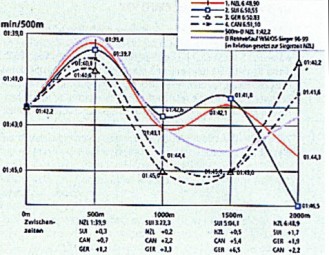 On the first half of the 2000m distance, the curve of Waddell (NZL) is running nearly parallel to the “example Curve” out of the split of all WM/OS-winners 1996-99. Compared to the last year, he started the race very fast, because he might have felt, that Xeno Muller (SUI). Muller, 1998/99 well known, because of his perfect even race-split, but still “only”Silver-medallist, tried this year the common tactic, pushed the field from the start and had a close lead at 1000m. His attempt, to keep this pressure over the third quarter and achieve a bigger advance, was not successful. The continued hard fight was so tiring, that he was lucky to save the second position ahead of Hacker (GER), who was able to push very hard at the end. The unexpected fluctuation in the area between 1500 and 2000m shows, that even the reserves of Waddell, which usually seemed to have no end at all, are limited. With view on the strong speeding-up from Hacker on the last 500m, may let him ask himself the question, whether he might have had the possibility to row 2-3sec faster in the middle-phase of the race. H 2x
On the first half of the 2000m distance, the curve of Waddell (NZL) is running nearly parallel to the “example Curve” out of the split of all WM/OS-winners 1996-99. Compared to the last year, he started the race very fast, because he might have felt, that Xeno Muller (SUI). Muller, 1998/99 well known, because of his perfect even race-split, but still “only”Silver-medallist, tried this year the common tactic, pushed the field from the start and had a close lead at 1000m. His attempt, to keep this pressure over the third quarter and achieve a bigger advance, was not successful. The continued hard fight was so tiring, that he was lucky to save the second position ahead of Hacker (GER), who was able to push very hard at the end. The unexpected fluctuation in the area between 1500 and 2000m shows, that even the reserves of Waddell, which usually seemed to have no end at all, are limited. With view on the strong speeding-up from Hacker on the last 500m, may let him ask himself the question, whether he might have had the possibility to row 2-3sec faster in the middle-phase of the race. H 2x 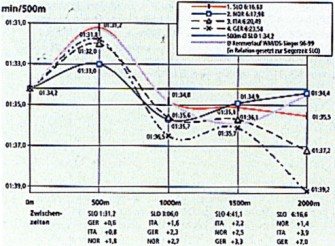 Classic race-tactic of the Slovenian Double; fast start. Successful counter against the attacks of ITA and NOR, even if NOR closed up to 1,4sec, after 2,7sec distance. NOR saved the silver medal ahead of ITA and GER, with their often shown economic organization of their power (widest range on 500m splits 2, 7 sec). The German boat lost the battle early in the middle-phase of the race, as they past ITA and now NOR followed, little bit faster, but with more even, velocity. They tried to follow until 1500m (deficit 3,3sec.), slowed down very strong, in a situation, as the battle for silver or bronze wasn decided yet. HPL 2x
Classic race-tactic of the Slovenian Double; fast start. Successful counter against the attacks of ITA and NOR, even if NOR closed up to 1,4sec, after 2,7sec distance. NOR saved the silver medal ahead of ITA and GER, with their often shown economic organization of their power (widest range on 500m splits 2, 7 sec). The German boat lost the battle early in the middle-phase of the race, as they past ITA and now NOR followed, little bit faster, but with more even, velocity. They tried to follow until 1500m (deficit 3,3sec.), slowed down very strong, in a situation, as the battle for silver or bronze wasn decided yet. HPL 2x 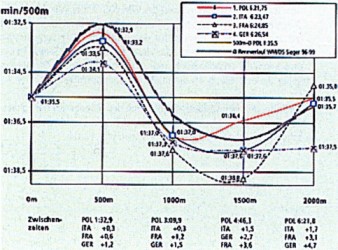 Superior power-demonstration in the Double from Poland, with a start-finish victory. Even race-course of GER, but 2 sec too slow on the second half. While GER kept their speed at the end-phase, FRA increased the speed on this part significantly, won more than one length against GER, and so got the bronze medal. H 4x
Superior power-demonstration in the Double from Poland, with a start-finish victory. Even race-course of GER, but 2 sec too slow on the second half. While GER kept their speed at the end-phase, FRA increased the speed on this part significantly, won more than one length against GER, and so got the bronze medal. H 4x 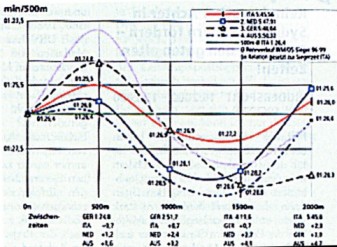 The German Quad rowed straight into the lead, seemingly without over pulling (Compared with the races in 1999WM and 1992 and 1996OS. But the advance they got to ITA was “only” a boat-length. The fight for the leading position was decided in the third quarter for the Italian boat. They rowed the same stroke-rate, but 1,4sec faster (12cm more drive every stroke! Compare diagram “stroke-rate and drive”. In reality ITA kept the speed in this phase, GER lost speed. ITA and also the, until this time with one boat-length distance following, NED could push and win speed in the end-phase. GER couldn`t respond (27 cm/stroke less drive) and lost the second position. - This leads to the conclusion, that the Italians showed a masterpiece in race-tactic / economic power-organization and rowing-technique. Race-tactic and power-organization won be an accident during this Final, seemed being planned. This is provable with comparable race-profiles during the “Semis”and in Lucerne.
The German Quad rowed straight into the lead, seemingly without over pulling (Compared with the races in 1999WM and 1992 and 1996OS. But the advance they got to ITA was “only” a boat-length. The fight for the leading position was decided in the third quarter for the Italian boat. They rowed the same stroke-rate, but 1,4sec faster (12cm more drive every stroke! Compare diagram “stroke-rate and drive”. In reality ITA kept the speed in this phase, GER lost speed. ITA and also the, until this time with one boat-length distance following, NED could push and win speed in the end-phase. GER couldn`t respond (27 cm/stroke less drive) and lost the second position. - This leads to the conclusion, that the Italians showed a masterpiece in race-tactic / economic power-organization and rowing-technique. Race-tactic and power-organization won be an accident during this Final, seemed being planned. This is provable with comparable race-profiles during the “Semis”and in Lucerne.
Rudersport 21/2000 W.Kollmann / Joern Grosskopf